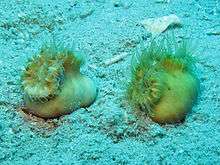Heteropsammia cochlea
| Heteropsammia cochlea | |
|---|---|
 | |
| Heteropsammia cochlea at Watson's Bay, Lizard Island, 17 metres depth | |
| Scientific classification | |
| Kingdom: | Animalia |
| Phylum: | Cnidaria |
| Class: | Anthozoa |
| Subclass: | Hexacorallia |
| Order: | Actiniaria |
| Suborder: | Dendrophylliina |
| Family: | Dendrophylliidae |
| Genus: | Heteropsammia |
| Species: | H. cochlea |
| Binomial name | |
| Heteropsammia cochlea Spengler, 1781) | |
Heteropsammia cochlea, also known as walking dendro, is a species of small lonely coral belonging to the Dendrophylliidae family native from the Indo-Pacific area.
Description
This small solitary free-living coral is not fixed to the substrate which the diameter does not exceed 2.5 cm.[2] It has a very particular shape making it easily identifiable, composed of one or two corallites and has a figure of eight when observed from top. The base in contact with the bottom is relatively circular, depending on the nature of the substrate it is either flat or slightly keeled. The base has often an orifice that houses a commensal worm belonging to the Aspidosiphonidae family.[3] The overall color is yellowish, grayish or greenish. The polyp tentacles are observable well deployed especially at night.
Distribution & habitat
The walking dendro is widespread throughout the tropical and subtropical waters of the Indo-West Pacific area from the eastern coasts of Africa, Red Sea included, to Philippines and from south Japan to Australia and New-Caledonia.[1][4]
This species likes flat bottom or even with a slight slope from one meter to 40 meters deep.[4]
Biology
The walking dendro is a common species that can be relatively abundant in some areas. It may have sexual reproduction with gamete release in water or asexually by budding of a new individual from the "parent body". It is important to note that there is no apparent sexual dimorphism between males and females. When breeding occurred in open water, the larva has a first stage of planktonic life before landing and grow on the shell of a microgastéropod that it will fully recover during growth.
To survive in its biotope and especially to avoid getting buried, this small coral have an obligate commensal relationship with a small tube worm belonging to the Aspidosiphonidae family , Aspidosiphon jukesi, which is housed under the base of coral.[4] The worm movements, in order to seek its food, allows the coral to avoid being buried. For cons, the coral is totally passive and dependent from its host travels. This small coral often has also a small parasitic mussel, Lithophaga lessepsiana.[2]
References
- 1 2 Hoeksema, B., Rogers, A. & Quibilan, M. 2008. Heteropsammia cochlea. The IUCN Red List of Threatened Species 2008: e.T133679A3861285. doi:10.2305/IUCN.UK.2008.RLTS.T133679A3861285.en. Downloaded on 23 September 2015.
- 1 2 "Heteropsammia cochlea. Corals of the World - Photos, maps and information about corals and reefs". coral.aims.gov.au. Retrieved 2015-09-29.
- ↑ LEON Virginie, PROUZET Anne, SCAPS Patrick, MITEL Cédric, in : DORIS, 21/3/2014 : Aspidosiphon muelleri Diesing, 1851, http://doris.ffessm.fr/fiche2.asp?fiche_numero=589
- 1 2 3 LEON Virginie, MITEL Cédric, in : DORIS, 17/3/2014 : Heteropsammia cochleata (Spengler, 1781), http://doris.ffessm.fr/fiche2.asp?fiche_numero=958
